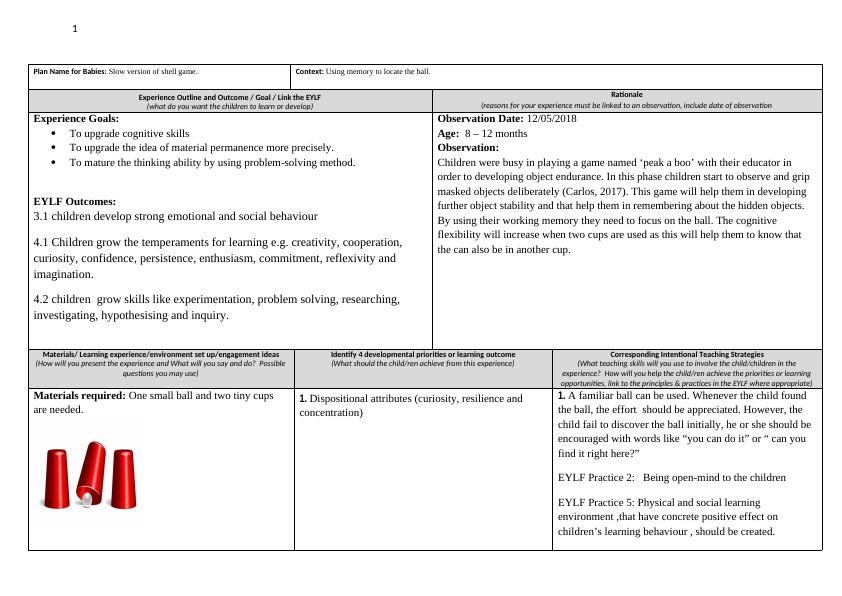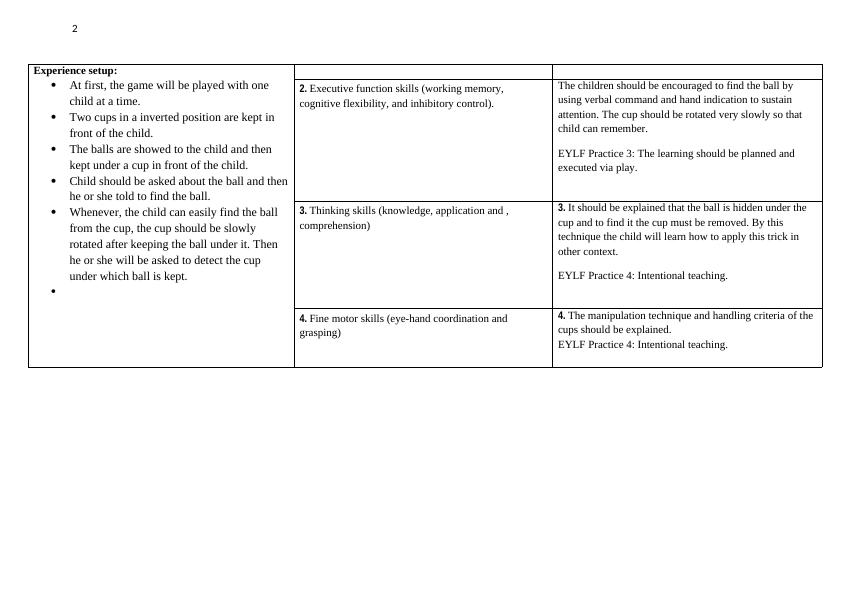Plan for Babies: Slow Version of Shell Game and Plan for Toddlers: Sorting Shapes
Added on 2023-06-03
7 Pages1562 Words483 Views

1
Plan Name for Babies: Slow version of shell game. Context: Using memory to locate the ball.
Experience Outline and Outcome / Goal / Link the EYLF
(what do you want the children to learn or develop)
Rationale
(reasons for your experience must be linked to an observation, include date of observation
Experience Goals:
To upgrade cognitive skills
To upgrade the idea of material permanence more precisely.
To mature the thinking ability by using problem-solving method.
EYLF Outcomes:
3.1 children develop strong emotional and social behaviour
4.1 Children grow the temperaments for learning e.g. creativity, cooperation,
curiosity, confidence, persistence, enthusiasm, commitment, reflexivity and
imagination.
4.2 children grow skills like experimentation, problem solving, researching,
investigating, hypothesising and inquiry.
Observation Date: 12/05/2018
Age: 8 – 12 months
Observation:
Children were busy in playing a game named ‘peak a boo’ with their educator in
order to developing object endurance. In this phase children start to observe and grip
masked objects deliberately (Carlos, 2017). This game will help them in developing
further object stability and that help them in remembering about the hidden objects.
By using their working memory they need to focus on the ball. The cognitive
flexibility will increase when two cups are used as this will help them to know that
the can also be in another cup.
Materials/ Learning experience/environment set up/engagement ideas
(How will you present the experience and What will you say and do? Possible
questions you may use)
Identify 4 developmental priorities or learning outcome
(What should the child/ren achieve from this experience)
Corresponding Intentional Teaching Strategies
(What teaching skills will you use to involve the child/children in the
experience? How will you help the child/ren achieve the priorities or learning
opportunities, link to the principles & practices in the EYLF where appropriate)
Materials required: One small ball and two tiny cups
are needed.
1. Dispositional attributes (curiosity, resilience and
concentration)
1. A familiar ball can be used. Whenever the child found
the ball, the effort should be appreciated. However, the
child fail to discover the ball initially, he or she should be
encouraged with words like “you can do it” or “ can you
find it right here?”
EYLF Practice 2: Being open-mind to the children
EYLF Practice 5: Physical and social learning
environment ,that have concrete positive effect on
children’s learning behaviour , should be created.
Plan Name for Babies: Slow version of shell game. Context: Using memory to locate the ball.
Experience Outline and Outcome / Goal / Link the EYLF
(what do you want the children to learn or develop)
Rationale
(reasons for your experience must be linked to an observation, include date of observation
Experience Goals:
To upgrade cognitive skills
To upgrade the idea of material permanence more precisely.
To mature the thinking ability by using problem-solving method.
EYLF Outcomes:
3.1 children develop strong emotional and social behaviour
4.1 Children grow the temperaments for learning e.g. creativity, cooperation,
curiosity, confidence, persistence, enthusiasm, commitment, reflexivity and
imagination.
4.2 children grow skills like experimentation, problem solving, researching,
investigating, hypothesising and inquiry.
Observation Date: 12/05/2018
Age: 8 – 12 months
Observation:
Children were busy in playing a game named ‘peak a boo’ with their educator in
order to developing object endurance. In this phase children start to observe and grip
masked objects deliberately (Carlos, 2017). This game will help them in developing
further object stability and that help them in remembering about the hidden objects.
By using their working memory they need to focus on the ball. The cognitive
flexibility will increase when two cups are used as this will help them to know that
the can also be in another cup.
Materials/ Learning experience/environment set up/engagement ideas
(How will you present the experience and What will you say and do? Possible
questions you may use)
Identify 4 developmental priorities or learning outcome
(What should the child/ren achieve from this experience)
Corresponding Intentional Teaching Strategies
(What teaching skills will you use to involve the child/children in the
experience? How will you help the child/ren achieve the priorities or learning
opportunities, link to the principles & practices in the EYLF where appropriate)
Materials required: One small ball and two tiny cups
are needed.
1. Dispositional attributes (curiosity, resilience and
concentration)
1. A familiar ball can be used. Whenever the child found
the ball, the effort should be appreciated. However, the
child fail to discover the ball initially, he or she should be
encouraged with words like “you can do it” or “ can you
find it right here?”
EYLF Practice 2: Being open-mind to the children
EYLF Practice 5: Physical and social learning
environment ,that have concrete positive effect on
children’s learning behaviour , should be created.

2
Experience setup:
At first, the game will be played with one
child at a time.
Two cups in a inverted position are kept in
front of the child.
The balls are showed to the child and then
kept under a cup in front of the child.
Child should be asked about the ball and then
he or she told to find the ball.
Whenever, the child can easily find the ball
from the cup, the cup should be slowly
rotated after keeping the ball under it. Then
he or she will be asked to detect the cup
under which ball is kept.
2. Executive function skills (working memory,
cognitive flexibility, and inhibitory control).
The children should be encouraged to find the ball by
using verbal command and hand indication to sustain
attention. The cup should be rotated very slowly so that
child can remember.
EYLF Practice 3: The learning should be planned and
executed via play.
3. Thinking skills (knowledge, application and ,
comprehension)
3. It should be explained that the ball is hidden under the
cup and to find it the cup must be removed. By this
technique the child will learn how to apply this trick in
other context.
EYLF Practice 4: Intentional teaching.
4. Fine motor skills (eye-hand coordination and
grasping)
4. The manipulation technique and handling criteria of the
cups should be explained.
EYLF Practice 4: Intentional teaching.
Experience setup:
At first, the game will be played with one
child at a time.
Two cups in a inverted position are kept in
front of the child.
The balls are showed to the child and then
kept under a cup in front of the child.
Child should be asked about the ball and then
he or she told to find the ball.
Whenever, the child can easily find the ball
from the cup, the cup should be slowly
rotated after keeping the ball under it. Then
he or she will be asked to detect the cup
under which ball is kept.
2. Executive function skills (working memory,
cognitive flexibility, and inhibitory control).
The children should be encouraged to find the ball by
using verbal command and hand indication to sustain
attention. The cup should be rotated very slowly so that
child can remember.
EYLF Practice 3: The learning should be planned and
executed via play.
3. Thinking skills (knowledge, application and ,
comprehension)
3. It should be explained that the ball is hidden under the
cup and to find it the cup must be removed. By this
technique the child will learn how to apply this trick in
other context.
EYLF Practice 4: Intentional teaching.
4. Fine motor skills (eye-hand coordination and
grasping)
4. The manipulation technique and handling criteria of the
cups should be explained.
EYLF Practice 4: Intentional teaching.

End of preview
Want to access all the pages? Upload your documents or become a member.
Related Documents
Ice-Cream Math: A Hands-On Mathematical Activity for Childrenlg...
|4
|798
|165
Early Childhood Education and Carelg...
|10
|1605
|201
Developmental Summarylg...
|4
|550
|471
Experience Plan for ECTPP102A Play and Documentationlg...
|8
|2096
|262
EDEC 203 Lesson Planning Template for Number Recognitionlg...
|5
|1373
|468
Writing Teaching Resourceslg...
|3
|537
|47
